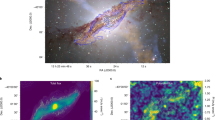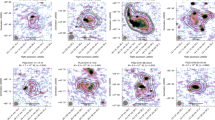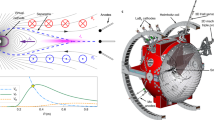Abstract
THE idea that large-scale ordered magnetic fields might reside in the gaseous coronae of spiral galaxies came first from theoretical arguments1 that such fields could be generated in situ by turbulent hydromagnetic dynamos. Here we put this general argument into practice. The partially ionized gas in galactic coronae is in chaotic motion, both turbulent and convective, and owing to galactic rota-tion acquires a non-zero mean helicity. Differential rotation and this helicity generate a magnetic field with predicted magnitude ∼1 νG and with a scale comparable to that of the corona. This field is nearly independent of the disk magnetic field: the two have different symmetry with respect to the galactic equator, the disk field being even and the corona field odd. Consequently, a galactic-scale neutral sheet arises ∼ 1 kpc above one side of the disk. At heights of about 3–5 kpc, the poloidal magnetic field component dominates the corona, a result consistent with observations of polarization in the galaxy NGC4631.
This is a preview of subscription content, access via your institution
Access options
Subscribe to this journal
Receive 51 print issues and online access
$199.00 per year
only $3.90 per issue
Buy this article
- Purchase on Springer Link
- Instant access to full article PDF
Prices may be subject to local taxes which are calculated during checkout
Similar content being viewed by others
References
Ruzmaikin, A. A., Shukurov, A. M. & Sokoloff, D. D. Magnetic Fields of Galaxies (Kluwer, Dordrecht, 1988).
Badwhar, G. D. & Stephens, S. A. Astrophys. J. 212, 494–506 (1977).
Webster, A. Mon. Not. R. astr. Soc. 185, 507–520 (1978).
Phillipps, S., Kearsey, S., Osborne, J. L., Haslam, H. & Stoffel, H. Astr. Astrophys. 103, 405–414 (1981).
Beuermann, K., Kanbach, G. & Berkhuijsen, E. M. Astr. Astrophys. 153, 17–34 (1985).
Sofue, Y., Fujimoto, M. & Wielebinski, R. A. Rev. Astr. Astrophys. 24, 459–498 (1986).
Hummel, E., Lesch, H., Wielebinski, R. & Schlickeiser, R. Astr. Astrophys. 197, L29–L31 (1988).
Parker, E. N. Cosmical Magnetic Fields (Clarendon, Oxford, 1979).
Krause, F. & Radler, K-H. Mean-Field Magnetohydrodynamics and Dynamo Theory (Pergamon, Oxford, 1980).
Ruzmaikin, A., Sokoloff, D. & Shukurov, A. Nature 336, 341–347 (1988).
Shapiro, P. R. & Field, G. B. Astrophys. J. 205, 762–765 (1976).
Savage, B. D. & Massa, D. Astrophys. J. 314, 380–396 (1987).
Sokoloff, D. & Shukurov, A. Geophys. Astrophys. Fluid Dyn. (submitted).
Kyazumov, G. A. Astr. Zh. (SSSR) 61, 846–853 (1984).
Ruzmaikin, A. A., Sokoloff, D. D. & Kovalenko, A. V. Soviet Astr. 22, 395–401 (1978).
Kvasz, L., Sokoloff, D. & Shukurov, A. Geophys. Astrophys. Fluid Dyn. (submitted).
Author information
Authors and Affiliations
Rights and permissions
About this article
Cite this article
Sokoloff, D., Shukurov, A. Regular magnetic fields in coronae of spiral galaxies. Nature 347, 51–53 (1990). https://doi.org/10.1038/347051a0
Received:
Accepted:
Issue Date:
DOI: https://doi.org/10.1038/347051a0
This article is cited by
-
Probing Magnetic Fields with Square Kilometre Array and its Precursors
Journal of Astrophysics and Astronomy (2016)
-
Spinning a tangled web
Nature (1991)
Comments
By submitting a comment you agree to abide by our Terms and Community Guidelines. If you find something abusive or that does not comply with our terms or guidelines please flag it as inappropriate.



